Published:
Author: Antonio Maria Guerra
Leonardo Da Vinci Wine
THE GREAT PASSION OF LEONARDO FOR WINE

Probably not everyone knows that Leonardo da Vinci, the renowned scientist and artist, had a great passion for wine and its world. Let’s find out this little known aspect of the Tuscan genius, with the precious help of Luca Maroni, esteemed enologist and great expert on the topic.

Wine: the great passion of Leonardo's family.
One of the main reasons for the interest of Leonardo toward wine was the place of origin of his family: Vinci, a small village in the marvelous Tuscan countryside.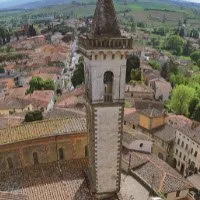
Located on the slopes of Montalbano, at an altitude between 100 and 200 meters above sea level, this village is surrounded by a hilly landscape, characterized by gentle slopes and very good exposure to the sun: the ideal place for the cultivation of vines and olive trees. Therefore, it’s no coincidence that Leonardo’s father invested a good amount of money (*1) in the purchase of agricultural plots around Vinci. Moreover, many members of his family were involved in wine-making activities, as his uncle Francesco and his grandfather Antonio, who did not disdain to work the vineyards ‘by their own hands’.
Vinci, the birthplace of Leonardo da Vinci.
The birthplace of Leonardo was Vinci, a small village not very distant from the Italian city of Florence.


The life of Leonardo da Vinci.
Leonardo was born in Vinci on 15 April 1452.
Read more
He spent a great part of his childhood in the countryside surrounding this village and Bacchereto, another village located on the eastern slope of the mount ‘Montalbano’. In Florence he became a pupil of Andrea del Verrocchio, attending his workshop. He left it in 1478, when he was 25 years old, and began a brilliant career, expressing his genius as a scientist and artist at the service of some of the most powerful people of the time, such as Ludovico Sforza (in Milan) and Cesare Borgia (in Cesena). His creativity knew no bounds, providing his clients with sculptures, paintings, architectural projects, engineering studies and, more in general, masterworks that still today have no equal. In 1515 he moved to France, employed by King Francis I. He died at Clos Lucé on May 2, 1519, at the age of 67.

Leonardo Da Vinci wine and grapes in a letter.
There is a letter from Leonardo, published for the first time in the book ‘The Life of Leonardo da Vinci’ by John William Brown (1828), in which the Tuscan genius shows all his expertise as an agronomist. Here follows a brief excerpt:
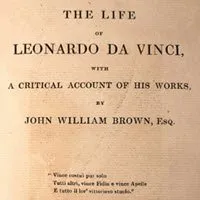 “You know that I also said that you should fertilize the rope when it is inserted in the ground with the rubble of works or of demolished walls, and this dries the root, the stem, and so the leaves from the air attract the substances suitable for the perfection of the bunch. Then pessimally for our days we made wine in open tanks, and so the essence of the fruit in the boiling has escaped through the air, and there is nothing left but a moist and faded colored of the skins and of the pulp; then the wine is not moved from one tank to another how it should be done, and for this reason the wine is made turbid and heavy for the bowels.”.
“You know that I also said that you should fertilize the rope when it is inserted in the ground with the rubble of works or of demolished walls, and this dries the root, the stem, and so the leaves from the air attract the substances suitable for the perfection of the bunch. Then pessimally for our days we made wine in open tanks, and so the essence of the fruit in the boiling has escaped through the air, and there is nothing left but a moist and faded colored of the skins and of the pulp; then the wine is not moved from one tank to another how it should be done, and for this reason the wine is made turbid and heavy for the bowels.”.
This writing is de facto a small treatise on viticulture and enology, describing the method to optimize the quality of the grapes and the technique to transform them into a wine of excellence, as underlined by the author himself in the final part: “Conciosiacosache si voi et altri faciesti senno di tale ragioni, berremmo vino excellente” (“… this means that if you will follow my recommendations, you will drink an excellent wine”).
Read more
Leonardo desires above all to preserve the original essence of the fruit, at the same time preventing the wine to become unpleasant to the senses and heavy for the stomach: for this reason:
1) It should ferment in closed barrels to avoid the oxidation-evaporation of the original taste and the irreversible loss of the intrinsic aroma;
2) It should be decanted frequently and carefully to keep it as clean as possible, removing all the fermentation residues (the ‘dregs’).

Leonardo’s grapes.
In his writings, Leonardo explicitly mentions only 3 types of Italian grapes: Passerina, Malvagia (Malvasia) and Moscado. They are cultivated still today.
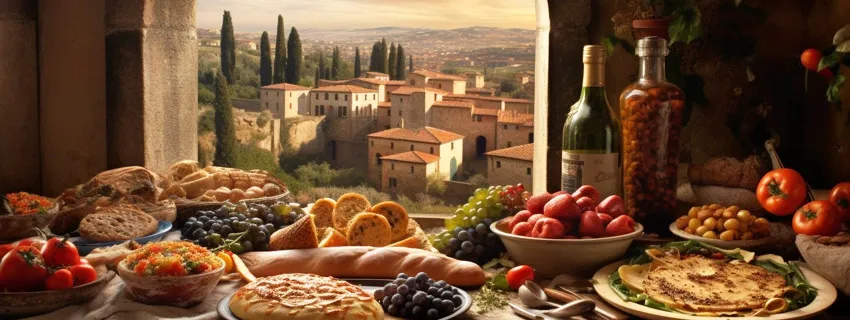
Leonardo Da Vinci and food.
Leonardo’s diet during his childhood and adolescence was based on the typical products of the countryside around Vinci and Montalbano: bread, oil, salad, vegetables, cheeses, cold cuts, meat, eggs and fruit.
Read more
The same types of food were part of his shopping list when he lived in Milan. There is no evidence that he was a vegetarian, contrary to what is sometimes claimed.

Leonardo Da Vinci wine: a genius in Romagna.
During the year 1502, Leonardo spent much time in Romagna (*1), since he had been invited by Duke Valentino (*2) to supervise the building of some military and civil structures. This stay gave him the opportunity to learn more about viticulture and enology. His attention focused in particular on a hanging system that allows the drying of grapes.
Read more
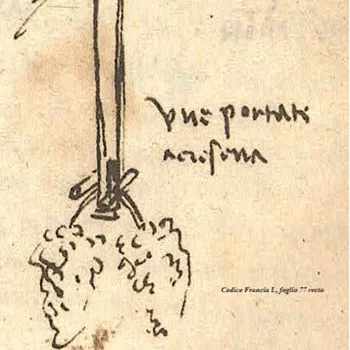 On this occasion, the scientist depicted some bunches in one of its drawings: today this drawing is particularly precious because it’s the only one of this type that has come down to us.
On this occasion, the scientist depicted some bunches in one of its drawings: today this drawing is particularly precious because it’s the only one of this type that has come down to us.
It should be noted that, during the same stay in Romagna, Leonardo visited the ancient Malatesta Library in Cesena, where he consulted the rare fourteenth-century Codex ‘De Ruralibus Commodis’ by Pier de ‘Crescenzi (1233-1320) (*3): this gave a noticeable boost to his knowledge of vine cultivation and winemaking.
Notes:
*1: Romagna is an Italian Region.
*2: Cesare Borgia.
*3: Pier de ‘Crescenzi composed this treatise using ancient sources and drawing on his personal experience.

Fiesole, the flying machine and wine.
Leonardo used part of the money he earned in Romagna, at the service of Cesare Borgia, and in Milan, at the service of the Sforza, to buy of a small plot near Fiesole, in Tuscany (*1). This land, located on the slopes of Monte Ceceri, in 1506, became the test site for the flying machine of his invention.
Read more
It’s interesting to find out that the same place is mentioned in a letter sent by Leonardo to his farmer, in which he regrets the poor taste of the wine produced, thus suggesting improvements for the cultivation of the vine.
Notes:
*1: They were actually two adjoining plots.
*2: The test was successful thanks to courage of Tommaso Masini, also known ‘Zoroastro da Peretola’: It was the first human flight in history.

The merits and the risks of wine according to Leonardo.
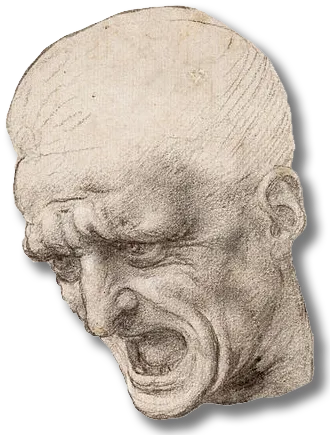 “As soon as the wine enters the stomach starts to boil inflating it and the soul leaves the body; the brain sometimes is turned to the sky, sometimes is tainted, going crazy and provoking irreparable errors.”
“As soon as the wine enters the stomach starts to boil inflating it and the soul leaves the body; the brain sometimes is turned to the sky, sometimes is tainted, going crazy and provoking irreparable errors.”
Keeping this in mind, Leonardo recommended some rules to drink wine the right way:
“Wine should never be too strong: it should be drunk little and often. Not outside the meal nor on an empty stomach.”
Just a few, simple suggestions, to keep drinking only a pleasure.
It’s also important to remember that a small addition of water was often used to moderate the intensity and thus the perception of the flaws caused by the primitive winemaking techniques used at the time.

Man is what he eats ( … and drinks).
Leonardo was fully aware of the fundamental role of food in human existence.
Read more
If I eat good food and drink good wine in the right amount and in the right way, I’ll be fine. If I eat bad food and drink bad wine without limits and in the wrong way, I’ll feel bad. We are not just what we eat, but also what we digest or not.
“Such is the nourishment, such is the nourished”
The scientist strongly believed that people should take responsibility for their own health, starting with their behaviour at the table table.
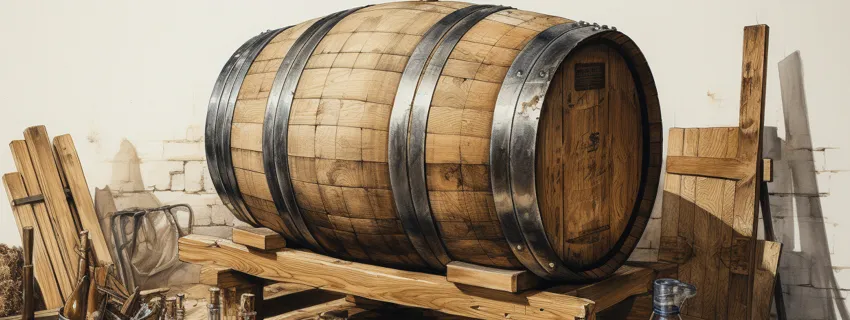
Leonardo Da Vinci wine: the barrique.
In the Codex Atlanticus by Leonardo there is a sketch representing a small barrel: it’s perhaps the first barrique in history.

Leonardo da Vinci studies the grapevine.
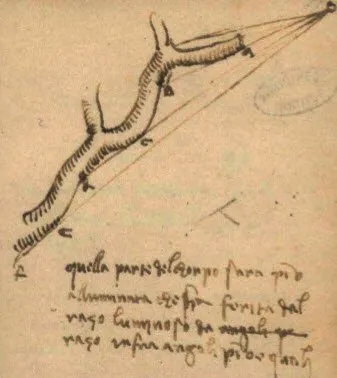 There are no doubts that Leonardo himself pruned vines and saw people carefully prune them: this way he could describe with great precision the effect of the cut on the sap circulation of the plant. In this regard, he wrote:
There are no doubts that Leonardo himself pruned vines and saw people carefully prune them: this way he could describe with great precision the effect of the cut on the sap circulation of the plant. In this regard, he wrote:
“Through water the ground gets its vital strength … as water flows from the roots of the vine to its branches and falls from their cuts only to be absorbed once again by the roots, the same way, from the lowest depth of the sea it reaches the top of the mountains only to go back to the sea through the rivers …”
Penetration, absorption, effusion, resurrection: to work properly, the lung of nature needs the plants and their strength. Keeping this in mind, among all vegetables Leonardo elects the vine as the archetype for universal sap circulation.

Leonardo da Vinci’s paintings paid … with wine.
It’s interesting to find out that a genius like Leonardo received wine as payment for one of his works. This exactly what happened on September 1481, when he received “uno barile di vino vermiglio” (“a barrel of vermillion wine”) for his painting ‘Adoration of the Magi’, originally intended for the altar of the Convent of San Donato.


Leonardo’s vineyard.
Luca Maroni, author of ‘Leonardo and wine’, the book that inspired this article, in 2015 re-planted the ancient vineyard, located in the heart of the city of Milan, that once belonged to Leonardo da Vinci. A very difficult task, that succeeded also thanks to the lucky recovery of some original plants during the excavations carried out in 2008 in collaboration with the Faculty of Viticulture of the University of Milan. This recovery and the replanting are described in two works by Maroni himself: ‘Milan is Leonardo’s vineyard’ and ‘Leonardo da Vinci: the rediscovered vineyard’.
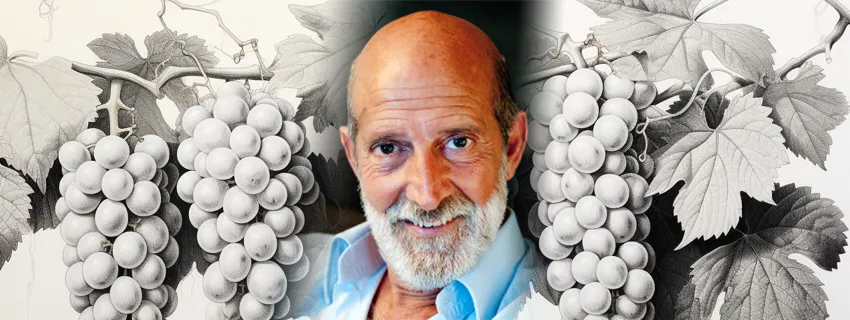
Luca Maroni, bio.
Luca Maroni, the author of the book that inspired this article, was born in Rome in 1961. Between 1987 and 1989, after classical studies, he graduated in Economics and worked with Luigi Veronelli to the wine tasting magazine ‘Ex Vinis’.
Read more
In 1993 he completed the first edition of the ‘Yearbook of the best Italian wines’. In 1995 he compiled the entry ‘Wine Tasting’ of the Treccani Italian Encyclopedia and in 2000 he founded the ‘wine portal’ www.lucamaroni.com. It’s important to remember that, since 1988, Luca Maroni has written more than 80 books about the topic: it’s therefore not surprising that in 2012 he was awarded the Honoris Causa Ph.D. in Enogastronomic Sciences by the University of Messina.

“IL VINO E’ BONO, MA L’ACQUA AVANZA …”
“WINE IS GOOD, BUT WATER ADVANCES”
(Leonardo da Vinci)
Copyright information.
The images displayed in this page belong to WebFoodCulture and to Mr. Luca Maroni.








